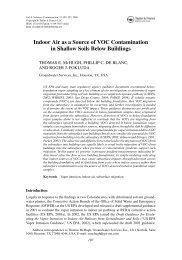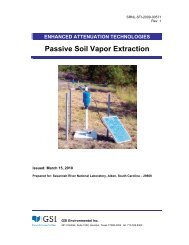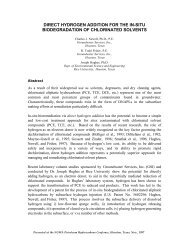Calculation and Use of First-Order Rate Constants for Monitored ...
Calculation and Use of First-Order Rate Constants for Monitored ...
Calculation and Use of First-Order Rate Constants for Monitored ...
You also want an ePaper? Increase the reach of your titles
YUMPU automatically turns print PDFs into web optimized ePapers that Google loves.
Appendix III. Effect <strong>of</strong> Dispersion, Sorption, Biodegradation, <strong>and</strong> Source Decay onConcentration vs. Time Pr<strong>of</strong>ilesINTRODUCTION: Concentration versus time pr<strong>of</strong>iles <strong>for</strong> a hypothetical case were generated using the Domenico solution to theadvection-dispersion-biodegradation equation along the centerline <strong>of</strong> a plume to illustrate the impact <strong>of</strong> the different attenuationparameters on the point attenuation rate at two different locations, one near the source area <strong>and</strong> the other 200 ft downgradient fromthe source.DATA: The parameters assumed <strong>for</strong> this example are as follows:v s= 100 ft/yr (median value from the HGDB database (Newell et al., 1990)), Y = 40 ft , α y= 0.1 α x, b = 10 ft (source thickness used<strong>for</strong> the Bioscreen runs)CALCULATION: Four different scenarios were considered to estimate the effect <strong>of</strong> the different parameters on the overall attenuationrate: 1) the only process acting at the plume is dispersion (α = 100 ft); 2) previous scenario plus the effect <strong>of</strong> sorption (R=5); 3)xdispersion, sorption, <strong>and</strong> biodegradation (λ=0.2 per yr) are acting; <strong>and</strong> 4) previous scenario plus the effect <strong>of</strong> source decay (k =source0.139 per yr).For each scenario, the Domenico solution was applied to obtain concentrations at two locations: one near the source area (X=20 ft)<strong>and</strong> the other at a point located 200 ft downgradient from the source as a function <strong>of</strong> time. As illustrated in the figures below, whenrunning Concentration vs. Time pr<strong>of</strong>iles, a decline in concentration near the source is not observed unless the source is decaying.Without source decay, the concentrations increase until they reach a steady-state maximum value <strong>and</strong> thereafter remain constanteven when dispersion, sorption, <strong>and</strong> biodegradation are present at a site (scenarios 1, 2, <strong>and</strong> 3). On the other h<strong>and</strong>, when sourcedecay is included, concentrations increase up to a maximum <strong>and</strong> decrease with time. (Note the two graphs have different scales).Concentration (mg/L)Concentration (mg/L)12108642Near source locationDispersiont s-s=15 yr,C max=9.5 mg/LDispersion+Sorptiont s-s =75 yr,C max=9.5 mg/LDispersion+Sorption+Biodegradationt s-s=12 yr,C max=8.4 mg/LDispersion+Sorption+Biodegradation+Source decayt s-s=3 yr, C max= 3.9 mg/Lk point =0.121/year00 5 10 15 20 25 30Time (yr)54.543.532.521.510.50Dispersiont s-s =15 yr,C max=4.7 mg/LDispersion+Sorptiont s-s=100 yr, C max =4.7Dispersion+Sorption+Biodegradationt s-s=12 yr, C max =1.3 mg/LDispersion+Sorption+Biodegradation+Source decayt s-s=10 yr, C max =0.6 mg/Lk point=0.0629/yr0 5 10 15 20 25 30Time (yr)Downgradient locationIt should be noted that while concentrations do notshow attenuation as a function <strong>of</strong> time without sourcedecay, a decrease in the maximum concentrationoccurs as a result <strong>of</strong> the various attenuationprocesses. For instance, the steady-stateconcentrations <strong>for</strong> the well located 20 ft from thesource area were 9.5 mg/L when only dispersion waspresent, 9.5 mg/L when both sorption <strong>and</strong> dispersionwere acting, 8.4 mg/L when dispersion, sorption <strong>and</strong>biodegradation were present, <strong>and</strong> 3.9 when sourcedecay was included. Similarly, <strong>for</strong> the point located200 ft from the source, maximum concentrations were4.7, 4.7, 1.3, <strong>and</strong> 0.6 mg/L <strong>for</strong> scenarios 1, 2, 3, <strong>and</strong>4, respectively. In other words, the more processesacting at a given site, the lower the maximumconcentration observed. In addition, the presence <strong>of</strong>different processes impacts the time required to reachsteady-state. For the source location, the time tosteady-state was 15, 75, 12, <strong>and</strong> 3 years <strong>for</strong>scenarios 1, 2, 3, <strong>and</strong> 4, respectively; whereas <strong>for</strong>the downgradient location, the time to steady-statewas 15, 100, 12, <strong>and</strong> 10 years <strong>for</strong> scenarios 1 to 4.This example illustrates the impacts <strong>of</strong> the variousattenuation processes on the maximumconcentrations observed at different locations withina plume. It can be inferred that the more processespresent at a given site, the lower the maximumconcentration observed. The effect <strong>of</strong> individualparameters on the Concentration vs. Time pr<strong>of</strong>iles isdiscussed below.20






